Rostow's Stages Theory of Economic Growth
VerifiedAdded on 2023/01/16
|9
|1720
|36
AI Summary
This article discusses Rostow's stages theory of economic growth, which includes the traditional society stage, take off preparation stage, take off period, maturity drive, and high mass stage of consumption. It explains the characteristics of each stage and their impact on development.
Contribute Materials
Your contribution can guide someone’s learning journey. Share your
documents today.
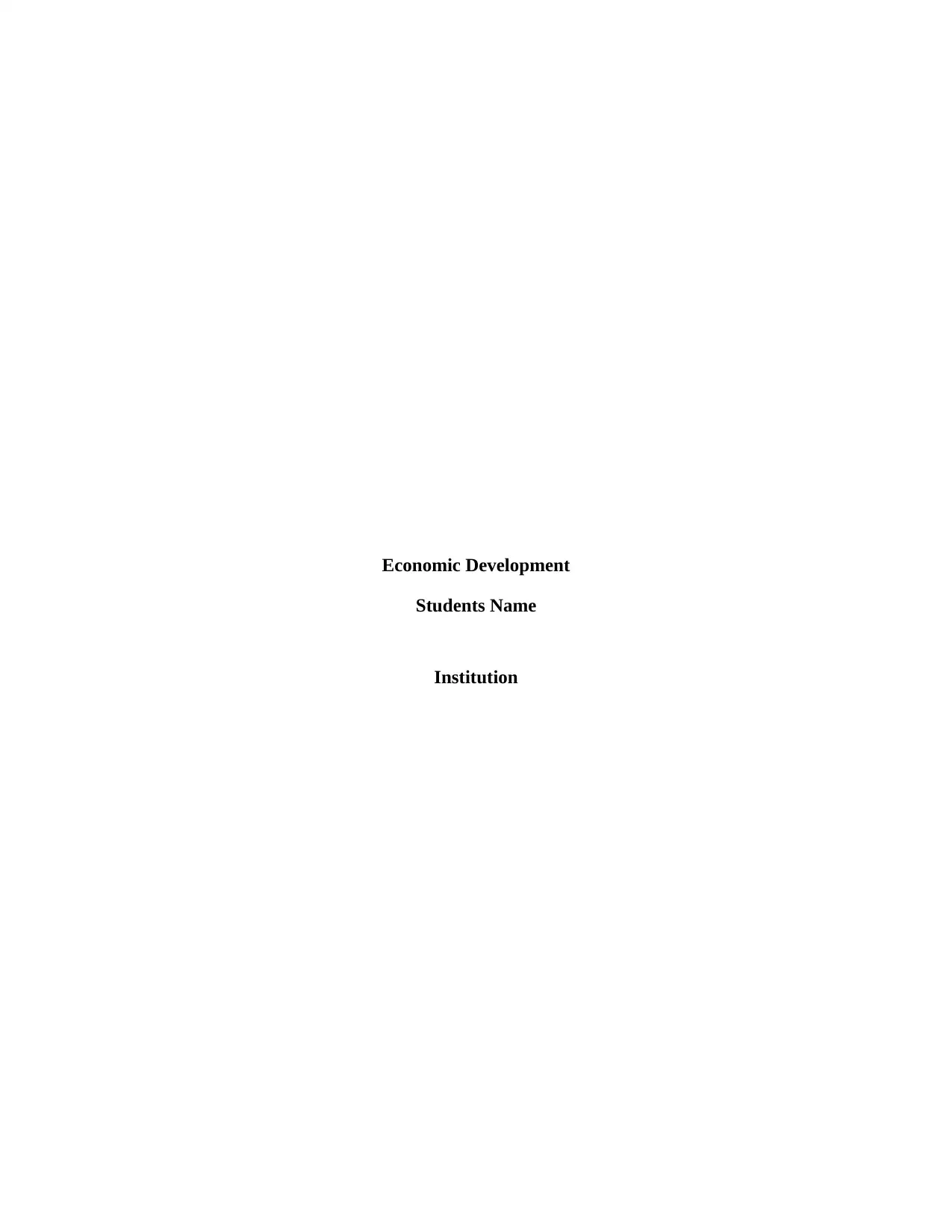
Economic Development
Students Name
Institution
Students Name
Institution
Secure Best Marks with AI Grader
Need help grading? Try our AI Grader for instant feedback on your assignments.
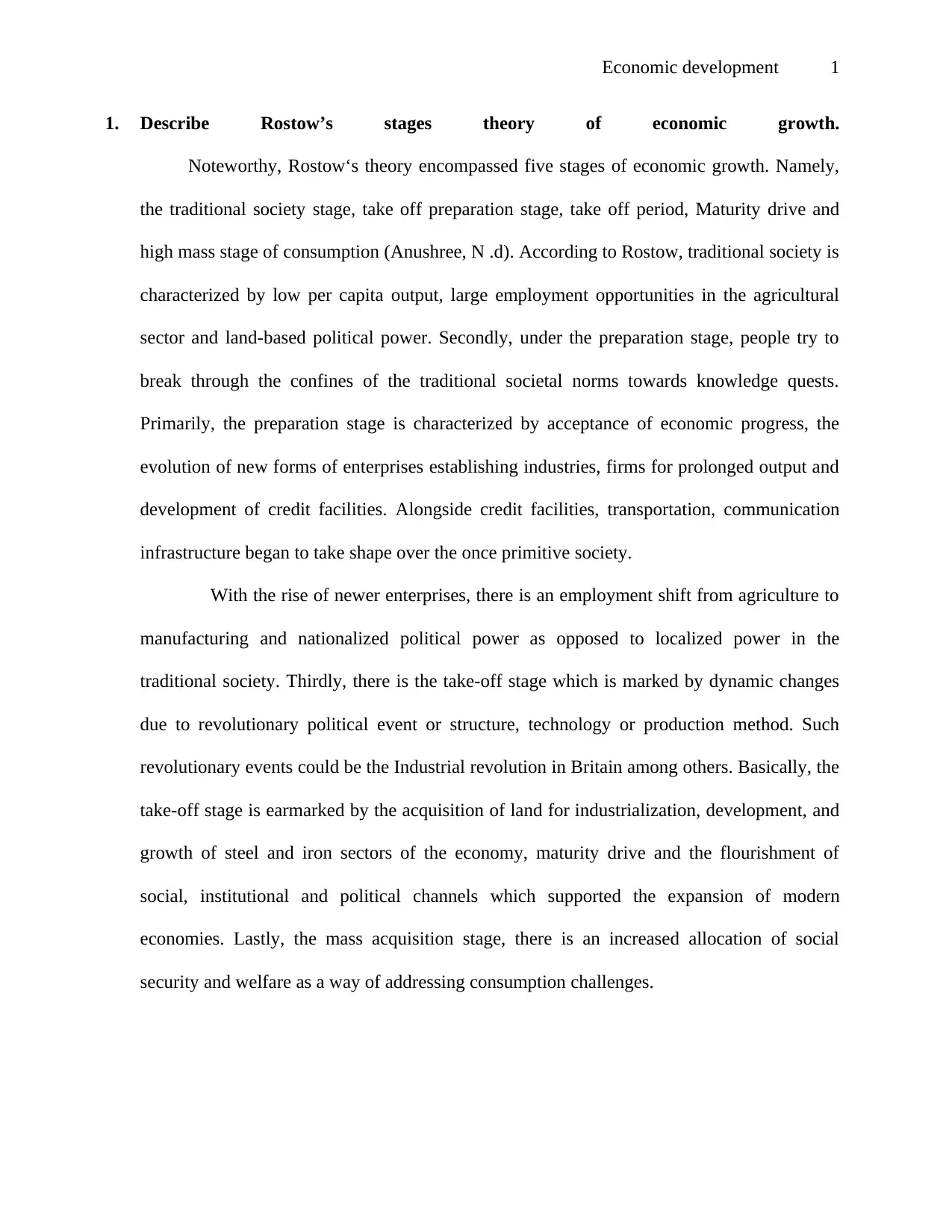
Economic development 1
1. Describe Rostow’s stages theory of economic growth.
Noteworthy, Rostow‘s theory encompassed five stages of economic growth. Namely,
the traditional society stage, take off preparation stage, take off period, Maturity drive and
high mass stage of consumption (Anushree, N .d). According to Rostow, traditional society is
characterized by low per capita output, large employment opportunities in the agricultural
sector and land-based political power. Secondly, under the preparation stage, people try to
break through the confines of the traditional societal norms towards knowledge quests.
Primarily, the preparation stage is characterized by acceptance of economic progress, the
evolution of new forms of enterprises establishing industries, firms for prolonged output and
development of credit facilities. Alongside credit facilities, transportation, communication
infrastructure began to take shape over the once primitive society.
With the rise of newer enterprises, there is an employment shift from agriculture to
manufacturing and nationalized political power as opposed to localized power in the
traditional society. Thirdly, there is the take-off stage which is marked by dynamic changes
due to revolutionary political event or structure, technology or production method. Such
revolutionary events could be the Industrial revolution in Britain among others. Basically, the
take-off stage is earmarked by the acquisition of land for industrialization, development, and
growth of steel and iron sectors of the economy, maturity drive and the flourishment of
social, institutional and political channels which supported the expansion of modern
economies. Lastly, the mass acquisition stage, there is an increased allocation of social
security and welfare as a way of addressing consumption challenges.
1. Describe Rostow’s stages theory of economic growth.
Noteworthy, Rostow‘s theory encompassed five stages of economic growth. Namely,
the traditional society stage, take off preparation stage, take off period, Maturity drive and
high mass stage of consumption (Anushree, N .d). According to Rostow, traditional society is
characterized by low per capita output, large employment opportunities in the agricultural
sector and land-based political power. Secondly, under the preparation stage, people try to
break through the confines of the traditional societal norms towards knowledge quests.
Primarily, the preparation stage is characterized by acceptance of economic progress, the
evolution of new forms of enterprises establishing industries, firms for prolonged output and
development of credit facilities. Alongside credit facilities, transportation, communication
infrastructure began to take shape over the once primitive society.
With the rise of newer enterprises, there is an employment shift from agriculture to
manufacturing and nationalized political power as opposed to localized power in the
traditional society. Thirdly, there is the take-off stage which is marked by dynamic changes
due to revolutionary political event or structure, technology or production method. Such
revolutionary events could be the Industrial revolution in Britain among others. Basically, the
take-off stage is earmarked by the acquisition of land for industrialization, development, and
growth of steel and iron sectors of the economy, maturity drive and the flourishment of
social, institutional and political channels which supported the expansion of modern
economies. Lastly, the mass acquisition stage, there is an increased allocation of social
security and welfare as a way of addressing consumption challenges.
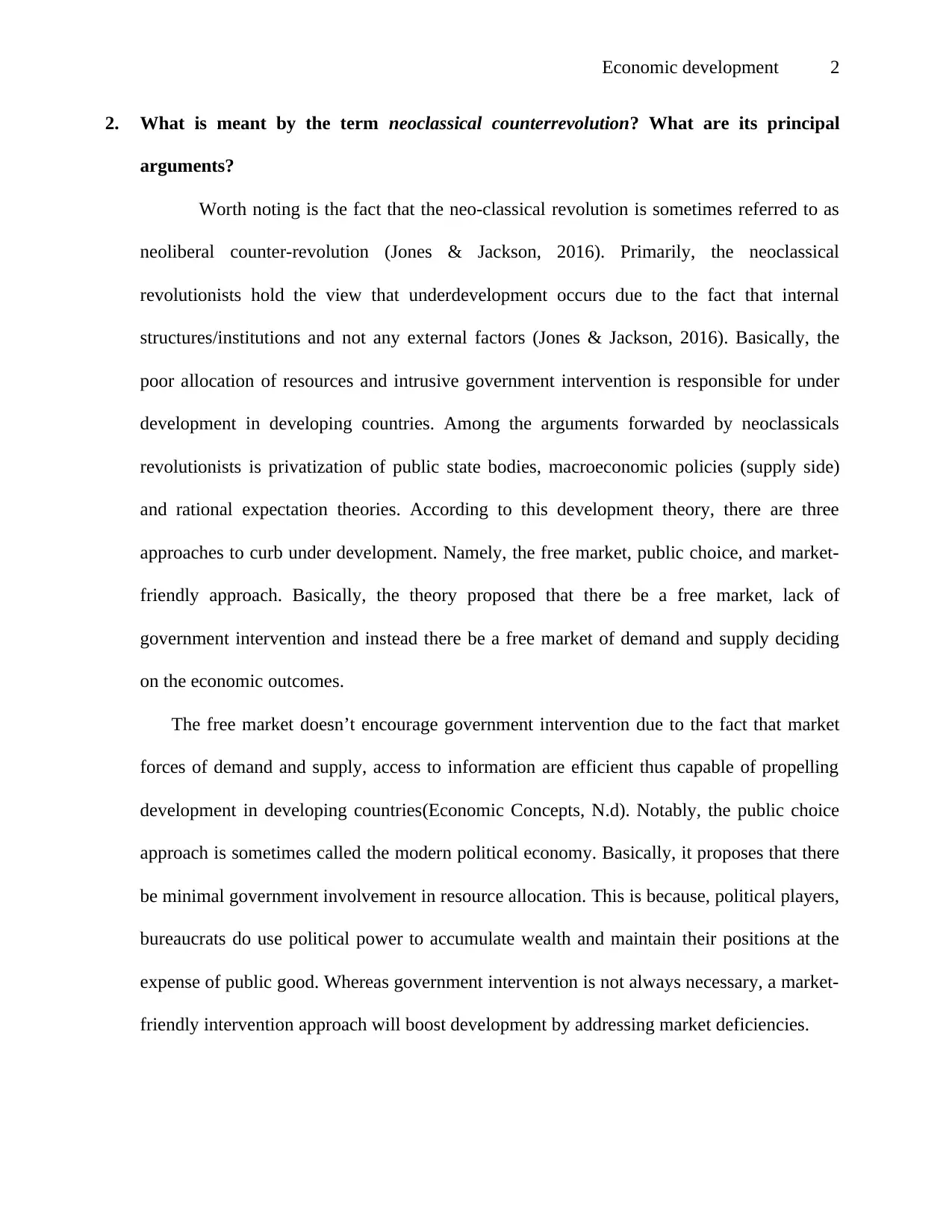
Economic development 2
2. What is meant by the term neoclassical counterrevolution? What are its principal
arguments?
Worth noting is the fact that the neo-classical revolution is sometimes referred to as
neoliberal counter-revolution (Jones & Jackson, 2016). Primarily, the neoclassical
revolutionists hold the view that underdevelopment occurs due to the fact that internal
structures/institutions and not any external factors (Jones & Jackson, 2016). Basically, the
poor allocation of resources and intrusive government intervention is responsible for under
development in developing countries. Among the arguments forwarded by neoclassicals
revolutionists is privatization of public state bodies, macroeconomic policies (supply side)
and rational expectation theories. According to this development theory, there are three
approaches to curb under development. Namely, the free market, public choice, and market-
friendly approach. Basically, the theory proposed that there be a free market, lack of
government intervention and instead there be a free market of demand and supply deciding
on the economic outcomes.
The free market doesn’t encourage government intervention due to the fact that market
forces of demand and supply, access to information are efficient thus capable of propelling
development in developing countries(Economic Concepts, N.d). Notably, the public choice
approach is sometimes called the modern political economy. Basically, it proposes that there
be minimal government involvement in resource allocation. This is because, political players,
bureaucrats do use political power to accumulate wealth and maintain their positions at the
expense of public good. Whereas government intervention is not always necessary, a market-
friendly intervention approach will boost development by addressing market deficiencies.
2. What is meant by the term neoclassical counterrevolution? What are its principal
arguments?
Worth noting is the fact that the neo-classical revolution is sometimes referred to as
neoliberal counter-revolution (Jones & Jackson, 2016). Primarily, the neoclassical
revolutionists hold the view that underdevelopment occurs due to the fact that internal
structures/institutions and not any external factors (Jones & Jackson, 2016). Basically, the
poor allocation of resources and intrusive government intervention is responsible for under
development in developing countries. Among the arguments forwarded by neoclassicals
revolutionists is privatization of public state bodies, macroeconomic policies (supply side)
and rational expectation theories. According to this development theory, there are three
approaches to curb under development. Namely, the free market, public choice, and market-
friendly approach. Basically, the theory proposed that there be a free market, lack of
government intervention and instead there be a free market of demand and supply deciding
on the economic outcomes.
The free market doesn’t encourage government intervention due to the fact that market
forces of demand and supply, access to information are efficient thus capable of propelling
development in developing countries(Economic Concepts, N.d). Notably, the public choice
approach is sometimes called the modern political economy. Basically, it proposes that there
be minimal government involvement in resource allocation. This is because, political players,
bureaucrats do use political power to accumulate wealth and maintain their positions at the
expense of public good. Whereas government intervention is not always necessary, a market-
friendly intervention approach will boost development by addressing market deficiencies.
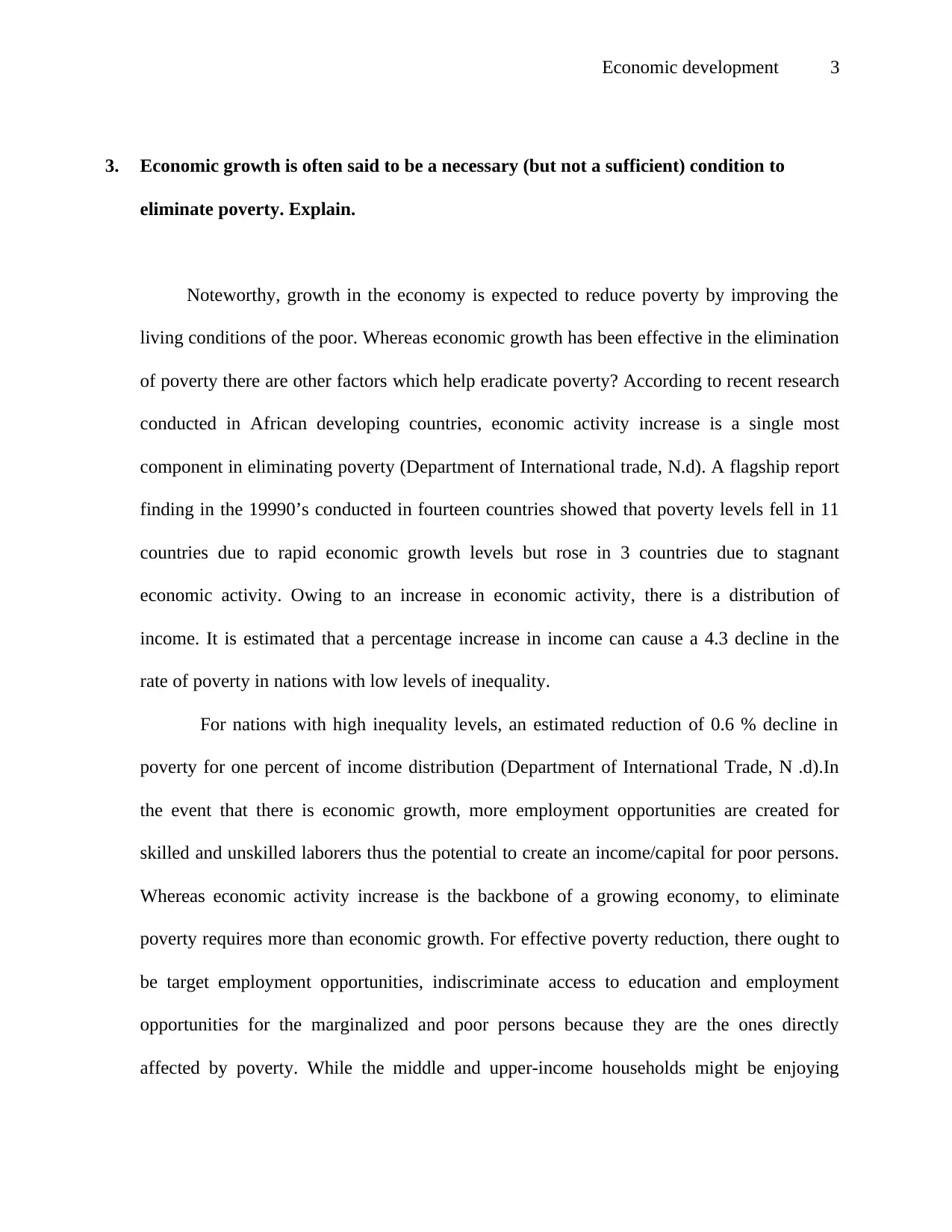
Economic development 3
3. Economic growth is often said to be a necessary (but not a sufficient) condition to
eliminate poverty. Explain.
Noteworthy, growth in the economy is expected to reduce poverty by improving the
living conditions of the poor. Whereas economic growth has been effective in the elimination
of poverty there are other factors which help eradicate poverty? According to recent research
conducted in African developing countries, economic activity increase is a single most
component in eliminating poverty (Department of International trade, N.d). A flagship report
finding in the 19990’s conducted in fourteen countries showed that poverty levels fell in 11
countries due to rapid economic growth levels but rose in 3 countries due to stagnant
economic activity. Owing to an increase in economic activity, there is a distribution of
income. It is estimated that a percentage increase in income can cause a 4.3 decline in the
rate of poverty in nations with low levels of inequality.
For nations with high inequality levels, an estimated reduction of 0.6 % decline in
poverty for one percent of income distribution (Department of International Trade, N .d).In
the event that there is economic growth, more employment opportunities are created for
skilled and unskilled laborers thus the potential to create an income/capital for poor persons.
Whereas economic activity increase is the backbone of a growing economy, to eliminate
poverty requires more than economic growth. For effective poverty reduction, there ought to
be target employment opportunities, indiscriminate access to education and employment
opportunities for the marginalized and poor persons because they are the ones directly
affected by poverty. While the middle and upper-income households might be enjoying
3. Economic growth is often said to be a necessary (but not a sufficient) condition to
eliminate poverty. Explain.
Noteworthy, growth in the economy is expected to reduce poverty by improving the
living conditions of the poor. Whereas economic growth has been effective in the elimination
of poverty there are other factors which help eradicate poverty? According to recent research
conducted in African developing countries, economic activity increase is a single most
component in eliminating poverty (Department of International trade, N.d). A flagship report
finding in the 19990’s conducted in fourteen countries showed that poverty levels fell in 11
countries due to rapid economic growth levels but rose in 3 countries due to stagnant
economic activity. Owing to an increase in economic activity, there is a distribution of
income. It is estimated that a percentage increase in income can cause a 4.3 decline in the
rate of poverty in nations with low levels of inequality.
For nations with high inequality levels, an estimated reduction of 0.6 % decline in
poverty for one percent of income distribution (Department of International Trade, N .d).In
the event that there is economic growth, more employment opportunities are created for
skilled and unskilled laborers thus the potential to create an income/capital for poor persons.
Whereas economic activity increase is the backbone of a growing economy, to eliminate
poverty requires more than economic growth. For effective poverty reduction, there ought to
be target employment opportunities, indiscriminate access to education and employment
opportunities for the marginalized and poor persons because they are the ones directly
affected by poverty. While the middle and upper-income households might be enjoying
Secure Best Marks with AI Grader
Need help grading? Try our AI Grader for instant feedback on your assignments.
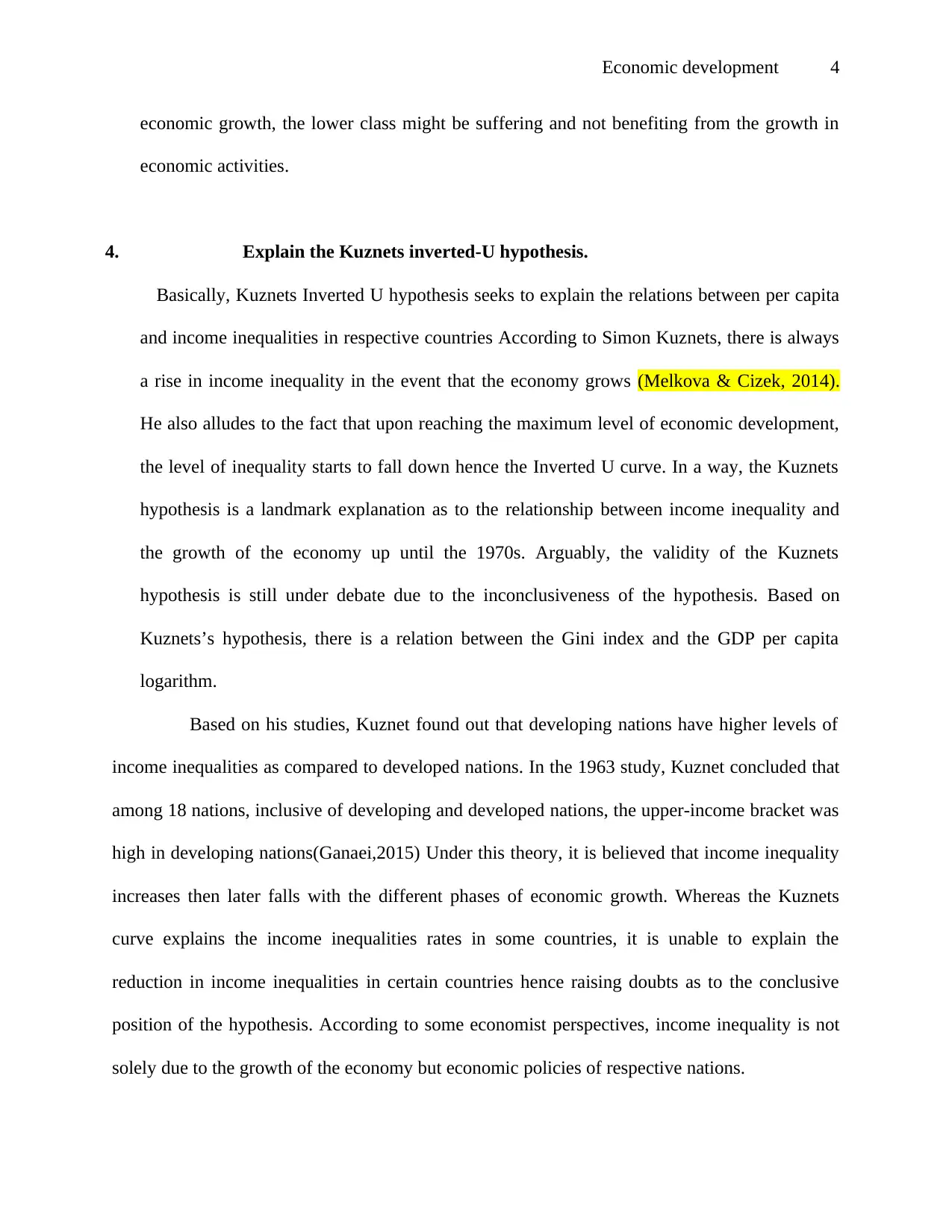
Economic development 4
economic growth, the lower class might be suffering and not benefiting from the growth in
economic activities.
4. Explain the Kuznets inverted-U hypothesis.
Basically, Kuznets Inverted U hypothesis seeks to explain the relations between per capita
and income inequalities in respective countries According to Simon Kuznets, there is always
a rise in income inequality in the event that the economy grows (Melkova & Cizek, 2014).
He also alludes to the fact that upon reaching the maximum level of economic development,
the level of inequality starts to fall down hence the Inverted U curve. In a way, the Kuznets
hypothesis is a landmark explanation as to the relationship between income inequality and
the growth of the economy up until the 1970s. Arguably, the validity of the Kuznets
hypothesis is still under debate due to the inconclusiveness of the hypothesis. Based on
Kuznets’s hypothesis, there is a relation between the Gini index and the GDP per capita
logarithm.
Based on his studies, Kuznet found out that developing nations have higher levels of
income inequalities as compared to developed nations. In the 1963 study, Kuznet concluded that
among 18 nations, inclusive of developing and developed nations, the upper-income bracket was
high in developing nations(Ganaei,2015) Under this theory, it is believed that income inequality
increases then later falls with the different phases of economic growth. Whereas the Kuznets
curve explains the income inequalities rates in some countries, it is unable to explain the
reduction in income inequalities in certain countries hence raising doubts as to the conclusive
position of the hypothesis. According to some economist perspectives, income inequality is not
solely due to the growth of the economy but economic policies of respective nations.
economic growth, the lower class might be suffering and not benefiting from the growth in
economic activities.
4. Explain the Kuznets inverted-U hypothesis.
Basically, Kuznets Inverted U hypothesis seeks to explain the relations between per capita
and income inequalities in respective countries According to Simon Kuznets, there is always
a rise in income inequality in the event that the economy grows (Melkova & Cizek, 2014).
He also alludes to the fact that upon reaching the maximum level of economic development,
the level of inequality starts to fall down hence the Inverted U curve. In a way, the Kuznets
hypothesis is a landmark explanation as to the relationship between income inequality and
the growth of the economy up until the 1970s. Arguably, the validity of the Kuznets
hypothesis is still under debate due to the inconclusiveness of the hypothesis. Based on
Kuznets’s hypothesis, there is a relation between the Gini index and the GDP per capita
logarithm.
Based on his studies, Kuznet found out that developing nations have higher levels of
income inequalities as compared to developed nations. In the 1963 study, Kuznet concluded that
among 18 nations, inclusive of developing and developed nations, the upper-income bracket was
high in developing nations(Ganaei,2015) Under this theory, it is believed that income inequality
increases then later falls with the different phases of economic growth. Whereas the Kuznets
curve explains the income inequalities rates in some countries, it is unable to explain the
reduction in income inequalities in certain countries hence raising doubts as to the conclusive
position of the hypothesis. According to some economist perspectives, income inequality is not
solely due to the growth of the economy but economic policies of respective nations.
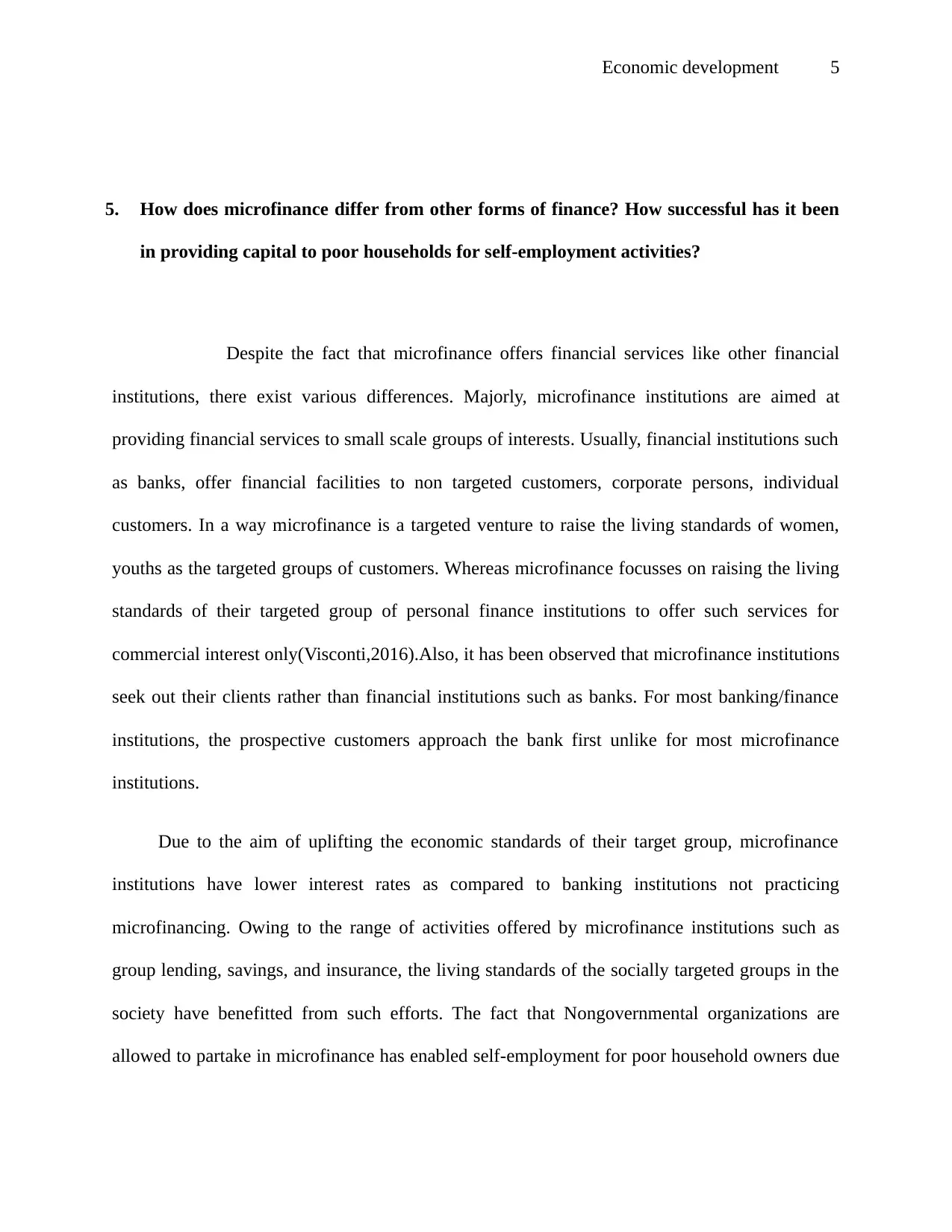
Economic development 5
5. How does microfinance differ from other forms of finance? How successful has it been
in providing capital to poor households for self-employment activities?
Despite the fact that microfinance offers financial services like other financial
institutions, there exist various differences. Majorly, microfinance institutions are aimed at
providing financial services to small scale groups of interests. Usually, financial institutions such
as banks, offer financial facilities to non targeted customers, corporate persons, individual
customers. In a way microfinance is a targeted venture to raise the living standards of women,
youths as the targeted groups of customers. Whereas microfinance focusses on raising the living
standards of their targeted group of personal finance institutions to offer such services for
commercial interest only(Visconti,2016).Also, it has been observed that microfinance institutions
seek out their clients rather than financial institutions such as banks. For most banking/finance
institutions, the prospective customers approach the bank first unlike for most microfinance
institutions.
Due to the aim of uplifting the economic standards of their target group, microfinance
institutions have lower interest rates as compared to banking institutions not practicing
microfinancing. Owing to the range of activities offered by microfinance institutions such as
group lending, savings, and insurance, the living standards of the socially targeted groups in the
society have benefitted from such efforts. The fact that Nongovernmental organizations are
allowed to partake in microfinance has enabled self-employment for poor household owners due
5. How does microfinance differ from other forms of finance? How successful has it been
in providing capital to poor households for self-employment activities?
Despite the fact that microfinance offers financial services like other financial
institutions, there exist various differences. Majorly, microfinance institutions are aimed at
providing financial services to small scale groups of interests. Usually, financial institutions such
as banks, offer financial facilities to non targeted customers, corporate persons, individual
customers. In a way microfinance is a targeted venture to raise the living standards of women,
youths as the targeted groups of customers. Whereas microfinance focusses on raising the living
standards of their targeted group of personal finance institutions to offer such services for
commercial interest only(Visconti,2016).Also, it has been observed that microfinance institutions
seek out their clients rather than financial institutions such as banks. For most banking/finance
institutions, the prospective customers approach the bank first unlike for most microfinance
institutions.
Due to the aim of uplifting the economic standards of their target group, microfinance
institutions have lower interest rates as compared to banking institutions not practicing
microfinancing. Owing to the range of activities offered by microfinance institutions such as
group lending, savings, and insurance, the living standards of the socially targeted groups in the
society have benefitted from such efforts. The fact that Nongovernmental organizations are
allowed to partake in microfinance has enabled self-employment for poor household owners due
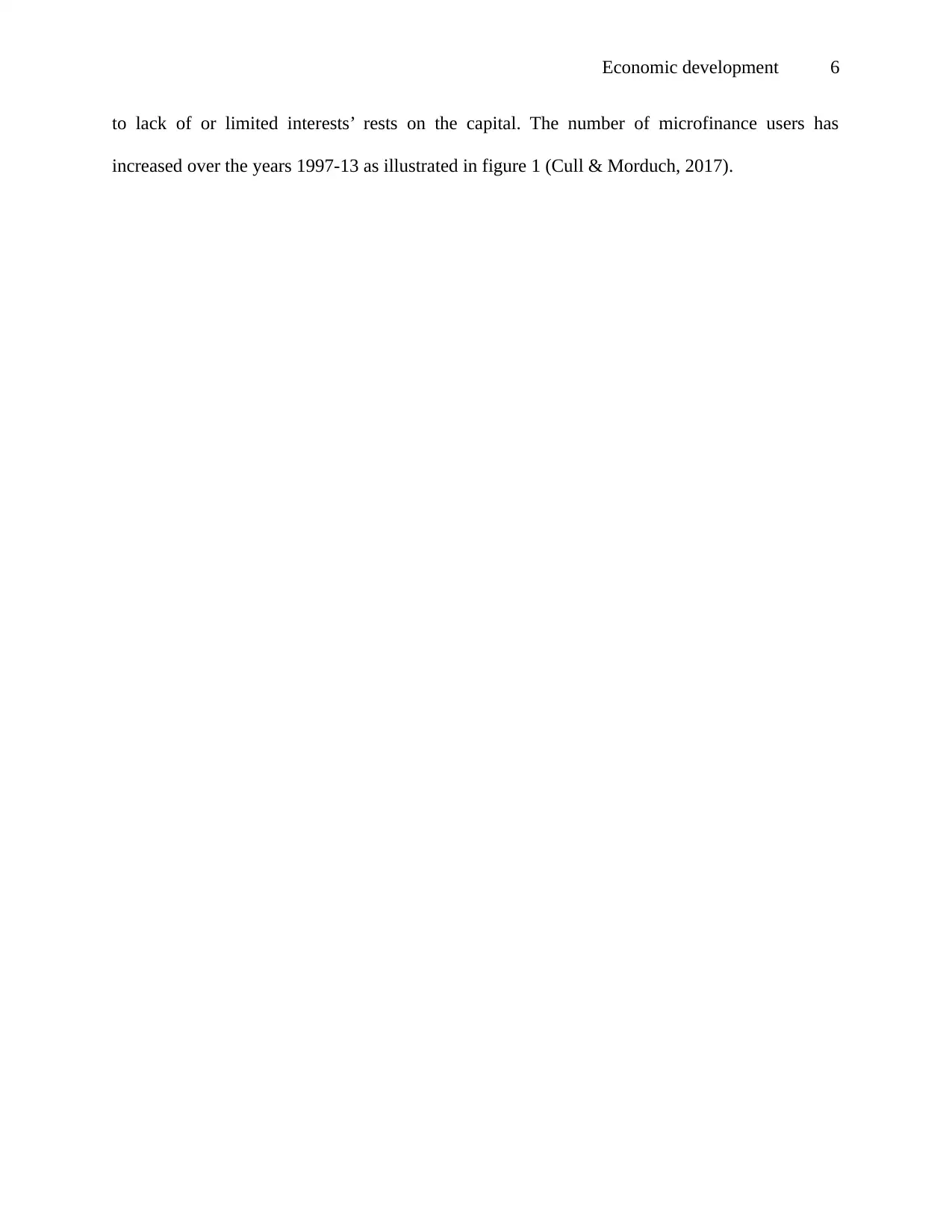
Economic development 6
to lack of or limited interests’ rests on the capital. The number of microfinance users has
increased over the years 1997-13 as illustrated in figure 1 (Cull & Morduch, 2017).
to lack of or limited interests’ rests on the capital. The number of microfinance users has
increased over the years 1997-13 as illustrated in figure 1 (Cull & Morduch, 2017).
Paraphrase This Document
Need a fresh take? Get an instant paraphrase of this document with our AI Paraphraser

Economic development 7
References
Anushree, A. (N .d). Rostow's Theory of Growth/Theories/Economics. Retrieved from
http://www.economicsdiscussion.net/theories/rostows-theory/rostows-theory-of-growth-
theories-economics/26745
Cull,R & Morduch,J..(2017).Microfinance and Economic development. Policy research
working paper 8252.Retrieved from
http://documents.worldbank.org/curated/en/107171511360386561/pdf/WPS8252.pdf
Department for international Development .(N .d).Growth Building jobs and prosperity in
developing countries. Retrieved from
https://www.oecd.org/derec/unitedkingdom/40700982.pdf
Economic Concepts. (N .d).Neo-classical counter-revolution Theory .Retrieved from
http://economicsconcepts.com/neo_classical_counter_revolution_theory.htm
Ganaie, A.A. (2015).Kuznets Inverted U Hypothesis of Income Inequality: Looking inside the
Available Economic Literature.Journal of poverty, Investment, and development.vol.9
Jones, S.D & Jackson, B (2016). The Neoclassical Counter-Revolution and the Ascendancy of
Business. Who runs the economy?. pp 73-84
Melkhova, J & Cizek, J.(2014). Kuznets inverted u-curve hypothesis examined on up-to-date
observations for 145 countries .Retrieved from
file:///C:/Users/Hp%20Folio/Downloads/490.pdf
References
Anushree, A. (N .d). Rostow's Theory of Growth/Theories/Economics. Retrieved from
http://www.economicsdiscussion.net/theories/rostows-theory/rostows-theory-of-growth-
theories-economics/26745
Cull,R & Morduch,J..(2017).Microfinance and Economic development. Policy research
working paper 8252.Retrieved from
http://documents.worldbank.org/curated/en/107171511360386561/pdf/WPS8252.pdf
Department for international Development .(N .d).Growth Building jobs and prosperity in
developing countries. Retrieved from
https://www.oecd.org/derec/unitedkingdom/40700982.pdf
Economic Concepts. (N .d).Neo-classical counter-revolution Theory .Retrieved from
http://economicsconcepts.com/neo_classical_counter_revolution_theory.htm
Ganaie, A.A. (2015).Kuznets Inverted U Hypothesis of Income Inequality: Looking inside the
Available Economic Literature.Journal of poverty, Investment, and development.vol.9
Jones, S.D & Jackson, B (2016). The Neoclassical Counter-Revolution and the Ascendancy of
Business. Who runs the economy?. pp 73-84
Melkhova, J & Cizek, J.(2014). Kuznets inverted u-curve hypothesis examined on up-to-date
observations for 145 countries .Retrieved from
file:///C:/Users/Hp%20Folio/Downloads/490.pdf

Economic development 8
Visconti, M.P. (2016).Microfinance Vs traditional banking in developing countries. Retrieved
fromhttps://www.researchgate.net/publication/302909379_
Microfinance_vs_traditional_banking_in_developing_countries
Visconti, M.P. (2016).Microfinance Vs traditional banking in developing countries. Retrieved
fromhttps://www.researchgate.net/publication/302909379_
Microfinance_vs_traditional_banking_in_developing_countries
1 out of 9
Your All-in-One AI-Powered Toolkit for Academic Success.
+13062052269
info@desklib.com
Available 24*7 on WhatsApp / Email
![[object Object]](/_next/static/media/star-bottom.7253800d.svg)
Unlock your academic potential
© 2024 | Zucol Services PVT LTD | All rights reserved.



